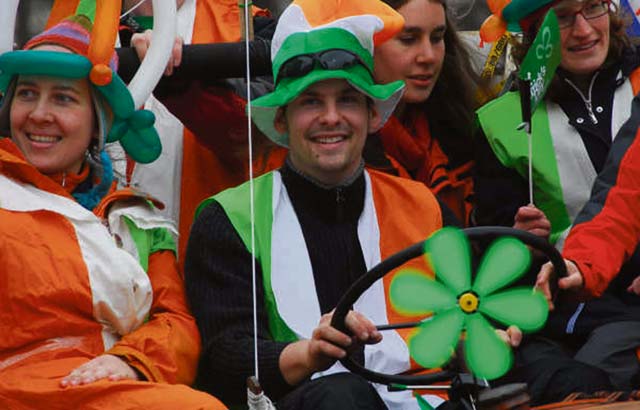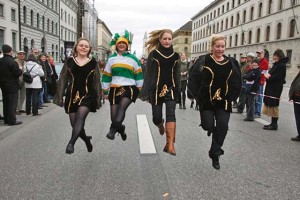
Members of the Irish-German Friendship Club take part in the St. Patrick’s Day parade starting at Münchner Freiheit.
The Irish celebrate a national and religious holiday Monday — St. Patrick’s Day.
St. Patrick’s Day is a day to honor Ireland’s first Christian missionary. March 17 is also an official holiday in Northern Ireland, the British overseas territory of Montserrat and the Canadian province of Newfoundland. Even in many other countries, Irish emigrants and even non-Irish celebrate the day with festivals, parades and other events.
The St. Patrick’s Day custom came to America in 1737. The first parade with 770 participants was held in 1843 in Chicago. Today, more than 100 cities in the states hold St. Patrick’s Day parades, the largest of which is in New York City.

In Germany, the Irish in Munich hold their 20th St. Patrick’s Day parade starting at noon Sunday from Münchner Freiheit leading to Odeonsplatz. At 12:45 p.m., a shamrock will be blessed and dignitaries will hold speeches before and after a parade party with an entertaining program that will continue until 5:30 p.m.
Another event highlighting St. Patrick’s Day will be the “Greening Flash Mob.” Visitors are asked to wear something green, come to Marienplatz and watch how the lights of Munich’s city hall change to green at 6:15 p.m. Tuesday.
In fact, St. Patrick was not Irish. He was reportedly born in Scotland around 385 near the town of Dumbarton. His real name is believed to be Maewyn Succat and his parents belonged to a Roman family of high rank.
Patrick lived a normal life for 16 years before he was captured by pirates and forced into slavery in Ireland. He was never interested in God or the church, but being away from home and all alone, he turned to God and learned to pray while herding sheep.
After being a slave for six years, Patrick dreamed that God told him it was time to go home. So he escaped on foot across 200 miles of unknown land. After an adventurous sea voyage, he finally returned home.
A couple of months later he visited St. Martin’s monastery at Tours and the island sanctuary of Lerins. Patrick placed himself under the guidance of a bishop, St. Germain. Several years later he was promoted to priesthood. He engaged in missionary works, and after the bishop recommended Patrick to the Pope, he traveled to Rome. Pope Celestine entrusted Patrick with the mission of bringing Christianity to Ireland.
Since he learned the Celtic language during his years of slavery, it was easy for him to spread the word of Christianity. He conquered one kingdom after another and destroyed Paganism.
Despite several death threats, Patrick baptized, confirmed, preached and built churches, schools and monasteries. St. Patrick was arrested several times, but he managed to escape each time. He succeeded in converting almost the entire population of the island.
Patrick died on March 17, 461, in Downpatrick, Ireland. That’s why St. Patrick’s Day is celebrated March 17.
There are many legends to tell about Patrick. One says he used the shamrock, which resembles a three-leafed clover, to explain the meaning of the trinity. He used it in his sermons to represent how the Father, the Son and the Holy Spirit could all exist as separate elements of the same entity. His followers adopted the custom of wearing a shamrock on his feast day.
Finding a four-leafed clover on St. Patrick’s Day is supposed to bring double good luck.
Kissing the Blarney Stone supposedly brings the kisser the gift of persuasive eloquence. The stone is set in the wall of the castle tower in the Irish village of Blarney. It is hard to reach being between the main castle wall and the parapet. Kissers have to lie on their backs and bend backward and downward, holding iron bars for support.
The origins of the Blarney Stone’s magical properties aren’t clear, but one legend says that an old woman cast a spell on the stone to reward a king who had saved her from drowning.
Also associated with the Irish holiday are leprechauns. Otherwise known as Irish fairies, leprechauns are small, unsociable, unfriendly men, who live alone. They are dressed like shoemakers, with a cocked hat and a leather apron.
Legend says they possess a hidden pot of gold. If the leprechaun is caught by a treasure hunter, he must give the hunter the location of the gold. If the leprechaun can trick the hunter and vanish, all hopes of finding the treasure are lost.
The color green is associated with St. Patrick’s Day because it is the color of spring, a shamrock and a color in Ireland’s flag. In many countries, people wear something green. School children started a tradition of their own — pinching classmates who forgot to wear green.







